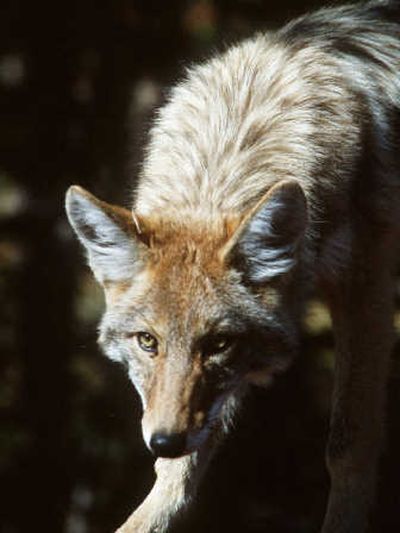Trail user flees coyote

A series of encounters between coyotes and Centennial Trail users – including a jogger chased Thursday night – has raised concerns the wild canines may be shedding some of their wariness toward humans.
More coyotes have been spotted across the region in recent years, but reports of close encounters have been rare until recently, said John McColgin, a Washington state Fish and Wildlife officer assigned to Spokane County.
Coyotes have approached joggers and walkers several times in recent months on sections of the Centennial Trail in the Spokane Valley, particularly in the area of Mirabeau Park, McColgin said. There have been no attacks, but Thursday night’s chase was too close for comfort.
“The incident is probably the most aggressive since I’ve been here,” said McColgin, who has worked as a wildlife officer for 32 years. “That’s why it concerns me a bit.”
Thursday’s encounter involved an unknown woman and her dog jogging near Mirabeau Park. Spokane Valley resident Mike Duggan was a passenger in a car driving by when he saw the woman running at full tilt with a panicked look on her face and a coyote less than 30 feet behind.
“She was running for her life. She had a can of mace in one hand and a cell phone in the other,” Duggan recalled Monday. “She was very scared. It was definitely going after her dog.”
The woman had been on the Centennial Trail and was jogging back to her home on Pines Road when Duggan saw her being chased about 6:30 p.m. By the time the car caught up with the woman, her dog was lagging behind on its leash and the coyote was about 10 feet farther back, said Duggan.
After honking the horn, the car’s driver pulled over and the terrified jogger and her dog jumped into the car. They drove the woman to her apartment, alerted authorities and then returned to Mirabeau Park to warn families with children to keep a close watch, Duggan said.
The growing boldness of coyotes is part of an overall trend of wildlife growing more comfortable around humans, McColgin said. Urban coyotes find easy food sources in backyards and no longer associate humans with danger.
“If there’s no danger to them, if they’re not afraid us, they’re going to continue to do that,” McColgin said of coyotes approaching people.
There’s no reason to avoid coyote-prone areas, McColgin said. People just need to remind coyotes of their place on the food chain by shouting at them or chasing them with sticks. Showing fear is a bad idea.
“Running away is not the answer. That’s exactly what their prey does,” McColgin said. “The only answer is to be as aggressive as you can when dealing with them.”
Although coyotes have been known to eat loose pets, attacks on humans are very rare and typically involve a person protecting a dog or cat. Stanley Gehrt, an assistant professor of environmental and natural resources at Ohio State University, has tracked and collared more than 300 urban coyotes in the Chicago area over the last seven years. Only five of those coyotes were known to have approached humans, he said.
The problem begins when people leave out food or when they run away the moment they spot a coyote.
“That usually starts the coyote down that slippery slope of familiarity towards people,” Gehrt said, adding that even coyotes used to people will typically turn tail and run when threatened.
Reports of coyotes in cities began picking up in the 1990s. Scientists aren’t entirely sure why – one reason might be a decline in fur prices that led to reduced trapping and hunting pressure, Gehrt said. Washington residents voted to outlaw most lethal forms of trapping in 2000.
Whatever happened, coyotes are thriving in urban areas, including places with little cover. Compared with their country cousins, urban coyotes have nearly double the odds of surviving their first year, according to Gehrt’s research.
The study also showed that although urban coyotes have been known to eat pets and garbage, these foods made up only 2 percent of scats sampled in the Chicago metro area. The remainder was their traditional foods of rodents, rabbits and fruit. Researchers also discovered urban coyotes finding a food source in Canada geese eggs.
Although deer, geese and raccoons have exploded in populations once they became established in urban settings, Gehrt said coyotes tend to self-regulate. “They won’t become superabundant. They’re going to figure out the food base and cap their population.”
On Monday, several hikers and cyclists on the Centennial Trail near Mirabeau Park said they weren’t concerned about reports of coyotes in the area.
“We’d be thrilled to see them,” said cyclist Sallye Prenger of Spokane. “We like wildlife.”
Spokane resident Dawn Reihardt said she feels sympathy for coyotes that have lost habitat along the Spokane River corridor because of the region’s booming growth.
“We’re in their territory,” she said. “I’m not saying I wouldn’t pee in my pants if I saw one.”